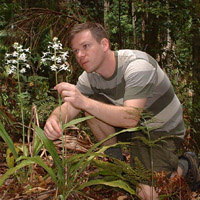View Cameron Painting -- Return to Paintings Home
 |
Ph.D.: University of North Carolina at Chapel Hill, 1996
Title: Assistant Curator
Research: Orchidaceae and monocots in general, Malpighiaceae
Although my research interests are broad, I continue to maintain a primary focus on the systematics, anatomy, phylogeny, and conservation of the orchid family (Orchidaceae). Most of my work is carried out within the laboratories of the Lewis B. and Dorothy Cullman Program for Molecular Systematics Studies, where I am using DNA sequence data to reconstruct the phylogenetic history of the orchids. The ultimate goal of this research is to produce a robust and stable system of classification for this diverse family, but also to understand its evolutionary history and the processes of evolution that have shaped it. In particular, I am a specialist on the orchid subfamily Vanilloideae, which includes the only orchid of agricultural value, Vanilla, and also a number of other genera that are endemic to such places as New Caledonia, Australia, South America, Africa, and eastern North America. This group of plants is pivitol to the study of orchid evolution and are fascinating in that several lineages have developed a parasitic relationship with fungi and can no longer photosynthesize on their own. In addition to orchids, I am currently using DNA sequencing tools to study biogeography, character evolution, and classification of the catbrier family (Smilacaceae), the malpigh family (Malpighiaceae), cacti (Cactaceae), and select carnivorous plant families.
The Green Swamp of southeastern North Carolina is depicted in my painting. This habitat is unique in that it contains a number of rare plant and animal species including the endangered red-cockaded woodpecker. Among the more interesting plants found here are a number of orchids and insectivorous plants, inlcuding the yellow pitcher plant (Sarracenia flava) and Venus' flytrap (Dionaea muscipula), which is found nowhere else in the world. The area is classified as a longleaf pine (Pinus palustris) savanna and requires regular burning to maintain its high level of species diversity. Both the pines and the wiregrass (Aristida stricta) below them are well adapted to fire, and the painting depicts these species in their different stages of growth after burning. At least 14 different orchid species can be found in the 16,000 acre Green Swamp Preserve which is maintained by the Nature Conservancy. Since my research is concerned with phylogenetic relationships in the orchid family, I asked Michael Rothman to include representatives of different orchid subfamilies as well as the yellow stargrass (Hypoxis hirsuta) of the Hypoxidaceae since that family has been shown to be sister to the orchids in molecular phylogenetic studies. From the orchid subfamily Epidendroideae is depicted Calopogon tuberosus with its pollinator, Bombus americanorum. Representing subfamily Sprinanthoideae and Orchidoideae are Spiranthes praecox and Platanthera ciliaris, respectively. Finally, the orchid subfamily Vanilloideae is represented by two species that I have studied extensively, Pogonia ophioglossoides and Cleistes divaricata. The painting is not only a beautiful representaion of this incredible plant community, but also serves to illustrate the fundamental biological concepts of convergent evolution between unrelated organisms, plant-animal coevolution, plant-plant competition, and phylogeny. In the same way that tropical rainforests around the world are rapidly disappearing, the Green Swamp and areas like it within our own country are being destroyed with little regard for the substantial biodiversity that they support. It is my hope that this painting will educate and inspire botanists and the public to protect national treasures like the Green Swamp, and to realize that some of Nature's greatest wonders can be found right in our own backyards.